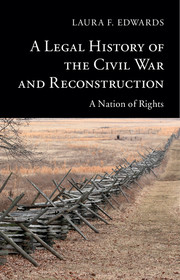Book contents
- Frontmatter
- Dedication
- Contents
- Acknowledgments
- Introduction
- 1 The United States and Its Use of the People
- 2 The Confederacy and Its Legal Contradictions
- 3 Enslaved Americans, Emancipation, and the Future Legal Order
- 4 The Federal Government and the Reconstruction of the Legal Order
- 5 The Possibilities of Rights
- 6 The Power of Law and the Limits of Rights
- Conclusion
- Bibliographic Essay
- Bibliography
- Index
- References
6 - The Power of Law and the Limits of Rights
Published online by Cambridge University Press: 05 February 2015
- Frontmatter
- Dedication
- Contents
- Acknowledgments
- Introduction
- 1 The United States and Its Use of the People
- 2 The Confederacy and Its Legal Contradictions
- 3 Enslaved Americans, Emancipation, and the Future Legal Order
- 4 The Federal Government and the Reconstruction of the Legal Order
- 5 The Possibilities of Rights
- 6 The Power of Law and the Limits of Rights
- Conclusion
- Bibliographic Essay
- Bibliography
- Index
- References
Summary
The U.S. Supreme Court’s decision in Muller v. Oregon (1908) is confusing. At issue was Oregon legislation that established a ten-hour day for women workers. Did the legislation represent a legitimate use of all states’ traditional authority (its police power, in legal terminology) to look after the welfare of the general public? Or did it violate the individual rights of workers, who should be able to decide on the terms of their labor contracts and who might want to work more than ten hours a day? The U.S. Supreme Court had come down on the side of contractual rights in the past, most forcefully in Lochner v. New York (1905). Legal historians generally identify Lochner as the culmination of judicial decisions that mostly restricted Fourteenth Amendment rights to those involving the economic activities necessary for property accumulation: the bundle of rights needed to pursue one’s livelihood. For people who had no choice but to work for someone else, that meant the right to enter into labor contracts – the right, simply, to work. In theory, workers were free to bargain with their employers as contractual equals, because the courts treated employers and even corporations as individuals in this area of law. In practice, most had absolutely no leverage and were forced to accept whatever terms their employers imposed.
This reading of rights was not just limited, but also highly individualized, based as it was on the presumption that all individuals were fully equal and equally able to control their own fates. In law, individuals might be equal, in the sense that they had access to the same bundle of rights and could, in theory, use them for their own benefit. In practice, however, it was painfully obvious that equality did not describe the conditions of late-nineteenth-century America. Even so, this conception of rights led courts to strike down all kinds of legislation designed to address inequalities that people, particularly wage workers, faced in the real world: low wages, long hours, dangerous working conditions, and a host of other issues over which they had little control. To uphold such legislation, as the decision in Lochner put it, would have generated inequality by treating workers as “wards of state,” instead of independent individuals. In Muller, however, the U.S. Supreme Court changed course, upholding Oregon’s ten-hour day legislation.
- Type
- Chapter
- Information
- A Legal History of the Civil War and ReconstructionA Nation of Rights, pp. 146 - 173Publisher: Cambridge University PressPrint publication year: 2015

